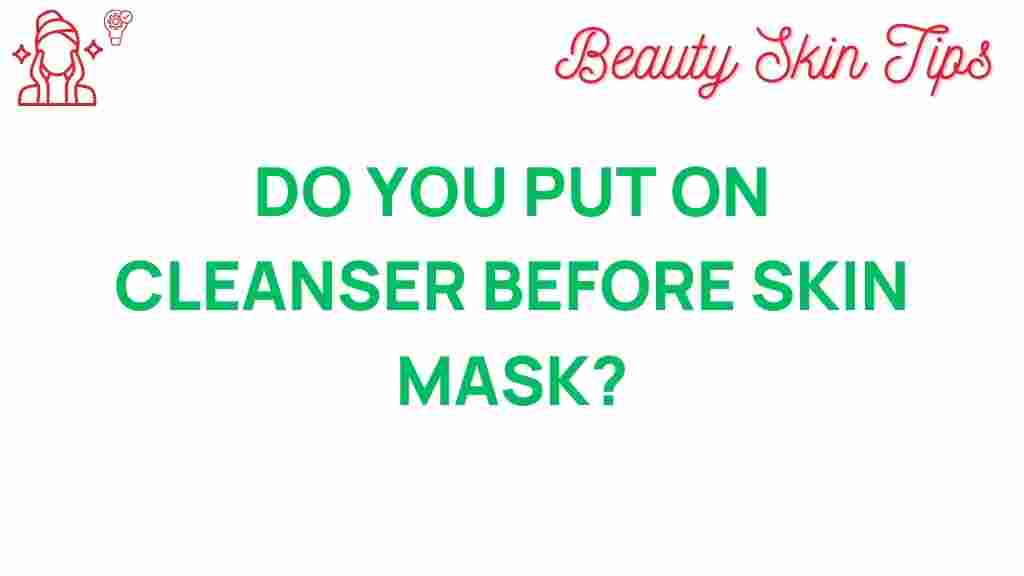Unlocking the Secret: Should You Cleanse Before a Face Mask?
When it comes to skincare, there are countless products and techniques that claim to give you the glowing skin you desire. Among these, face masks have gained immense popularity for their ability to nourish, hydrate, and rejuvenate the skin. However, a common question arises: should you use a cleanser before applying a face mask? In this article, we will explore the importance of cleansing, how it affects the efficacy of your face mask, and the best practices to ensure you maximize your skincare routine.
Why Cleansing is Essential
The first step in any effective skincare routine is cleansing. A good cleanser helps to remove dirt, oil, makeup, and impurities from the skin’s surface. Here are some compelling reasons why cleansing is crucial:
- Removes Impurities: Cleansing eliminates pollutants and residues that accumulate on your skin throughout the day.
- Prepares the Skin: A clean canvas allows your skincare products, including face masks, to penetrate better and work more effectively.
- Prevents Breakouts: Regular cleansing helps to keep your pores clear, reducing the risk of acne and other skin issues.
- Enhances Hydration: Cleansing can help balance your skin’s moisture levels, making it more receptive to hydrating products.
Now that we understand the importance of cleansing, let’s delve into whether you should cleanse before applying a face mask.
The Relationship Between Cleanser and Face Masks
Using a cleanser before a face mask is often recommended by skincare experts. Here’s why:
1. Boosts Efficacy
Cleansing your skin removes barriers that prevent the active ingredients in your face mask from penetrating deeply. Without a thorough cleanse, your skin may not absorb the mask’s benefits effectively.
2. Reduces Skin Irritation
Applying a face mask on unclean skin can trap dirt and oil, which may lead to irritation or breakouts. A cleanser preps your skin by ensuring it’s free of any unwanted buildup that could react negatively with the mask.
3. Tailors to Skin Type
If you use a specific cleanser tailored to your skin type (oily, dry, combination, or sensitive), it can help address particular skin concerns before the mask application. This can enhance the overall results.
4. Improves Overall Routine
Incorporating cleansing into your routine creates a more systematic approach to skincare. This habit not only benefits your face masks but also your overall skin health.
How to Properly Cleanse Before a Face Mask
To truly unlock the benefits of your face mask, it’s essential to cleanse correctly. Follow these steps for optimal results:
Step 1: Choose the Right Cleanser
Select a cleanser that suits your skin type:
- Foaming Cleanser: Ideal for oily or acne-prone skin.
- Cream Cleanser: Best for dry or sensitive skin.
- Gel Cleanser: Great for combination skin.
- Oil Cleanser: Effective for removing heavy makeup.
Step 2: Wash Your Hands
Always start by washing your hands to prevent transferring bacteria and dirt onto your face.
Step 3: Apply the Cleanser
Using your fingertips, apply the cleanser to your face. Use gentle, circular motions to massage the product in, focusing on areas that tend to get oily or congested.
Step 4: Rinse Thoroughly
Rinse your face with lukewarm water, ensuring all traces of the cleanser are removed. Pat your skin dry with a clean towel.
Step 5: Follow Up with Your Face Mask
Now that your skin is clean, you can apply your face mask of choice. Make sure to follow the instructions for the specific mask to achieve the best results.
Common Troubleshooting Tips
Even with the best intentions, you might encounter issues when cleansing before a face mask. Here are some common problems and how to address them:
Problem 1: Skin Irritation
If you experience irritation after using a cleanser or face mask, consider the following:
- Switch to a gentler, fragrance-free cleanser.
- Limit the frequency of mask application until your skin calms down.
- Patch-test new products before full application.
Problem 2: Not Seeing Results
If your face mask isn’t delivering the expected results, it could be due to improper cleansing:
- Ensure you are using the right cleanser for your skin type.
- Consider double cleansing if you wear makeup or sunscreen.
- Give your skin time to adjust to new products.
Problem 3: Breakouts
If you find that you’re breaking out more frequently after using a face mask:
- Make sure you’re using a non-comedogenic cleanser and mask.
- Limit the use of heavy products that could clog pores.
- Consult a dermatologist for personalized recommendations.
Conclusion
In summary, cleansing before applying a face mask is a crucial step in any skincare routine. Not only does it enhance the effectiveness of your mask, but it also prepares your skin to absorb all the nourishing ingredients effectively. By following the proper cleansing techniques and troubleshooting common issues, you can achieve the radiant skin you’ve always desired.
Remember, the key to a successful skincare routine is consistency and choosing products that best suit your skin type. For more tips on skincare routines, check out our detailed guide on skincare essentials.
If you’re interested in exploring different types of face masks to pair with your cleanser, visit this resource for more information!
This article is in the category Skincare and created by BeautySkinTips Team
